new posts in all blogs
Viewing: Blog Posts Tagged with: Latino, Most Recent at Top [Help]
Results 1 - 25 of 30
How to use this Page
You are viewing the most recent posts tagged with the words: Latino in the JacketFlap blog reader. What is a tag? Think of a tag as a keyword or category label. Tags can both help you find posts on JacketFlap.com as well as provide an easy way for you to "remember" and classify posts for later recall. Try adding a tag yourself by clicking "Add a tag" below a post's header. Scroll down through the list of Recent Posts in the left column and click on a post title that sounds interesting. You can view all posts from a specific blog by clicking the Blog name in the right column, or you can click a 'More Posts from this Blog' link in any individual post.

By:
Roger Sutton,
on 10/15/2015
Blog:
Read Roger - The Horn Book editor's rants and raves
(
Login to Add to MyJacketFlap)
JacketFlap tags:
News,
alphabet,
School,
Picture Books,
Home,
elementary school,
Featured,
Latino,
barrio,
Lolly's Classroom,
neigborhood,
Add a tag
 When I saw Welcome to My Neighborhood: A Barrio ABC at the library, I was immediately intrigued. I am always interested in books about people of color and since my daughter is half Latina, I wanted to see what this book was about.
When I saw Welcome to My Neighborhood: A Barrio ABC at the library, I was immediately intrigued. I am always interested in books about people of color and since my daughter is half Latina, I wanted to see what this book was about.
I’m all for “keeping it real,” but when I read the first page and saw that A was for Abuela — and for abandoned car — I wondered if this book was keeping it too real with its depictions of neighborhood blight. But as I flipped through it, I decided that it was not too much. Abandoned cars and other signs of neglect are a very real part of some kids’ lives. There is beauty everywhere in life and the narrator finds it in broken bottles “that are smashed like falling stars” and a vacant lot that has become a vegetable plot.
My husband, who is Puerto Rican, read the book to our daughter and when they got to the letter R, the book mentions Rincón, a town in Puerto Rico where he has family.
It is so very important to see yourself reflected in all types of media. And a book like this will probably be very affirming for kids who have similar experiences, but what about the kids that don’t immediately identify with the kind of neighborhood portrayed in the book?
The jacket copy suggests that after reading about this neighborhood, young readers can think about what is special about their neighborhoods. They can also reflect on memories that make their lives special because that is an important part of the book.
For example, if a student says the book doesn’t reflect his or her life, ask questions such as:
- If your Abuela doesn’t make ham and cheese or teach you to play dominoes, what special things do you share with your grandmother?
- People don’t play basketball where you live, okay, what do they play?
- The mother wants the children to remember certain things, specifically about their heritage and the narrator admits to forgetting Spanish words. What are adult always telling you to remember?
The post Welcoming everyone to the neighborhood appeared first on The Horn Book.

By: Contributing Bloguistas:,
on 7/25/2014
Blog:
La Bloga
(
Login to Add to MyJacketFlap)
JacketFlap tags:
bullying,
book review,
boys,
Chicano,
Latino,
#WeNeedDiverseBooks,
Boy Zorro,
El Nino Zorro,
first voice,
skin color in children's lit,
Add a tag
U.S. readers definitely need more and more diverse books. Especially for children, both Anglo and the marginalized children of color. A bilingual book by Kat Aragon, published last month, relates to that need, as well as to the U.S. sickness of bullying. Below is the publisher's description of Boy Zorro and the Bully (El Niño Zorro y el Peleón).
 • ISBN: 978-1-60448-027-6 • Paperback • $8.95
• ISBN: 978-1-60448-027-6 • Paperback • $8.95
• Ages 4 to 8 • 24 pages
• Bilingual English/Spanish edition
• Published: July, 2014http://www.lecturabooks.com/
"Every day Benny Lopez woke up looking for a way to help people. One day he finds a mask and wears it while helping an elderly lady cross a busy street. With that act of grace, he becomes Boy Zorro—defender of good. Then, one morning at school, he helps stop a bully from intimidating another student. The bully is punished and sees the error of his ways. Boy Zorro made a difference. This book helps children understand that bullying is hurtful and wrong but when everyone does their part, it can be stopped."
The motto of Zorro's publisher, Lectura Books, is: "for English learners and parent involvement." Below are my thoughts as a former teacher of latino first-graders, and father of a boy and a girl.
Zorrito, I'll call him, uses his outfit to empower himself and begin acting like a "hero" of good deeds. He's a great role model taking pride in his kind acts. It's great that the principal, Ramos, is a latino.
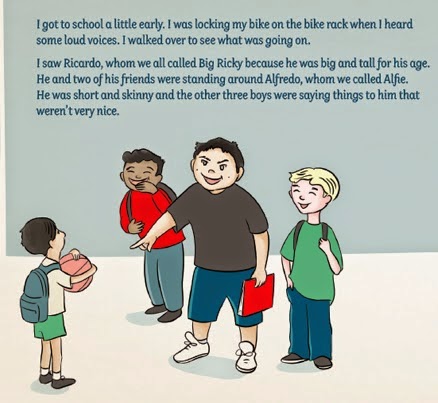 When he has a school encounter with a bigger kid who's bullying another kid, the action gets going. Zorrito "makes a difference" by running to the principal when the bully threatens him. He snitches, is what kids would call it.
When he has a school encounter with a bigger kid who's bullying another kid, the action gets going. Zorrito "makes a difference" by running to the principal when the bully threatens him. He snitches, is what kids would call it.
Telling an adult is one correct thing to do. One, but not the only thing. This book would be a good start for kids to discuss how to deal with bullying, as long as the discussion is extended to other methods and questions.
Like, what if there's no adult around? What if the bully doesn't let you go to tell an adult? After you tell, how will you deal with the accusation that you're a snitch?
One book can't cover all of life's possibilities. As I said, Zorro is a good start.
Recent studies and reports on school bullying have shifted away from just telling an adult. As a parent, I know kids need to learn many other things. When to run away. How not to get backed into a corner. How to try to get other kid-bystanders involved. As a parent, I told my kid it was okay if he was sent to the principal's office because he was defending himself. (I can hear you teachers cringing out there.)
In Zorro, the latino principal holds an assembly, tells the bully to apologize and admit his mistakes. He gets a week suspended from school and detention for a month after that. Pure punishment.
Bullies are a U.S. epidemic. Newer studies and reports, again, advocate treating that sickness. A bully at home for a week will not necessarily cure himself. Detention is a junior form of prison solitary. I know principals who prefer to keep bullies in the school, give or get them counseling and teach them why their bullying needs to be corrected. It's no simple task.
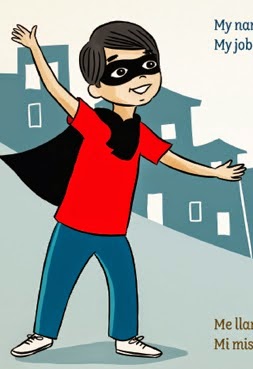 In Zorro, the bully problem has a positive outcome. For that reason it can help parents and kids see that they don't need to tolerate bullying.
In Zorro, the bully problem has a positive outcome. For that reason it can help parents and kids see that they don't need to tolerate bullying.
To encourage more books from this author and other latinos' books aimed at latino kids, I also looked at the illustrations. What struck me was the skin color of the characters. One black boy is the only one with dark skin. I saw no real color distinction between latino kids and ones who are assumedly Anglo. I wasn't sure why complexions were done this way.
Unless something was intended that I haven't thought of, I'd suggest to the illustrator, Noel Ill, that the skin tones of his afroamericano character would work for some latinos.
Teachers of latinoamericano kids deal with the color line every day. Darker kids can get shunned by lighter-skinned latino kids. Many kids call their color "blanco," to not be identified with what class society considers an "inferior" color or "inferior" race, like indios. It's not the kids' fault, it's a prejudice from the country they were raised in. Books aimed at them need to acknowledge that some do have darker skin. Otherwise one of our major, latino characteristics would get whitewashed. I'm not sure if anything good is served by that.
Females in the book: girls in the background who don't speak or play any role in the story. From experience, I believe--and have read--that boys will like books that include girls, so long as they're engaging books. I'm uncertain there's value in leaving girls totally out of any book. (The only other female is the elderly woman--maybe Anglo--who Zorrito helps to cross a street.)
Latino boys do need more books like Zorro, as well as "boy books" with girls, especially, playing greater roles as they do in real life.
To help publicize Zorro, I'll give the author, publisher, and illustrator, for that matter, space here if they would like to explain more about the book. Yes, I've examined a lot about it; such books are important, especially given that few are published each year. Because I'm Chicano, have taught bilingual latino kids, and hope to publish books aimed at them, I have a great interest in examining the work of other latinos.
Our First Voice books should aspire to be superior to others being written. If expecting books to meet such a standard offends someone, I prefer that to my saying nothing about our literature needing improvement. And when mine are published, I'll ask help holding them to similar standards.
Es todo, hoy,
RudyG, a.k.a. a former bilingual teacher and still a father
Estela Bernal made her debut as an author this past May with Can You See Me Now? (Pinata/Arte Publico). As you get to know her today and find out a little more about Can You See Me Now? you’ll be impressed but, be even more impressed to know that she’s donating 100% of her proceeds to education and animal rights.
Just a little about the book. Kirkus says:
Tragedy strikes on Mandy’s 13th birthday when her father is struck by a drunk driver and killed. Now grief—both her own and her mother’s—complicates the already confusing landscape of early adolescence.
 With her mother working more and more hours in the wake of her father’s death, Mandy begins spending most of her time living with her grandmother. Often the target of bullies, loner Mandy approaches Paloma to be her partner for a school project. Paloma is also a misfit, but she carries herself with a self-assured grace that Mandy finds compelling. As she becomes closer to Paloma, she learns about the practices of yoga and meditation, which are foundational in Paloma’s family. An overweight boy in class, Rogelio, is also touched by tragedy when his family’s home burns down, and Paloma invites him to join their yoga crew. As the three continue practicing together, they each begin to cultivate their own peace amid the chaos in their lives. Though each faces personal challenges, they find friendship and support in one another. Bernal has succeeded in crafting a story that acknowledges tragedy without wallowing in it, placing her emphasis on resilience and personal growth. The quick pace and distinctive characters make for a smooth, well-crafted read.
With her mother working more and more hours in the wake of her father’s death, Mandy begins spending most of her time living with her grandmother. Often the target of bullies, loner Mandy approaches Paloma to be her partner for a school project. Paloma is also a misfit, but she carries herself with a self-assured grace that Mandy finds compelling. As she becomes closer to Paloma, she learns about the practices of yoga and meditation, which are foundational in Paloma’s family. An overweight boy in class, Rogelio, is also touched by tragedy when his family’s home burns down, and Paloma invites him to join their yoga crew. As the three continue practicing together, they each begin to cultivate their own peace amid the chaos in their lives. Though each faces personal challenges, they find friendship and support in one another. Bernal has succeeded in crafting a story that acknowledges tragedy without wallowing in it, placing her emphasis on resilience and personal growth. The quick pace and distinctive characters make for a smooth, well-crafted read.
Middle-grade readers should respond to this tender story of learning to connect with others through open eyes and an open heart. (Fiction. 10-13)
And Estela’s interview!
Where did you grow up?
I grew up in South Texas (the Rio Grande Valley).

Estela Bernal
Do you have any pets?
I love animals and have had many pets through the years. I currently have two cats.
What were some of the first books you found as a child that turned you into a reader?
I grew up in a home where we had no books. There were no public libraries in my hometown either. Despite the lack of age-appropriate reading material, I fell in love with books as soon as I learned to read. I remember reading the Weekly Reader and whatever else I could get my hands on at school. Although I don’t remember where I got it, Pearl Buck’s The Good Earth was one book I read and re-read. I’ve always been a dreamer and this book opened up an exotic new and very fascinating world to me.
Meat or vegetables?
Vegetables, absolutely! As an animal lover, I volunteered with many animal welfare organizations until I was able to form my own. Through it I do community education and help provide low-cost spay/neuter services to residents’ pets in underserved communities. It would be hard to justify rescuing some animals while eating others. Besides, I find that when I eat a healthy diet, I feel so much better.
Which famous person would you most like to have write a review for your book?
So many famous and not-so-famous people come to mind. It always makes me happy to hear about celebrities and other public figures who are also great philanthropists and who help raise awareness about some very important issues facing society today. But there are also many unsung heroes quietly working to help make their communities better places to live. I sincerely believe we all have the potential to do good and that, after all, is what really matters. Two of my own favorite causes are education and animal welfare so my choice would have to be someone with similar ideals.
What three things would you like to add to a list of national treasures?
Although man-made treasures are priceless, I believe that natural treasures are absolutely essential. I’d love to see all public waterways, land (public, private, agricultural), and all living beings protected and preserved for our well-being and that of future.
Why would you be up at 3am?
Usually, I’m only up at that time if I’m traveling and have to catch an early flight.
What book(s) are you currently in the middle of reading?
I’m currently making my way through a 100 Greatest Books for Kids list and just started Pam Muñoz Ryan’s Becoming Naomi León. I’m also reading my latest copy of Glimmer Train.
What made you decide to write about a teen who discovers yoga?
One of my nephews died accidentally a few years ago. The accident happened in front of his wife and children and I began to wonder how such a tragic event would affect any family who witnessed such a tragedy. That also got me thinking about how a child, already weighed down by grief, would cope with the additional burden of parental abandonment and being bullied on top of everything else. Adolescence is tough enough as it is, and adding all this other stress can lead to such despair that anyone could easily be overwhelmed. I wanted to introduce the idea that there are alternatives to violence, that there is help even when we think there is no safe way out of certain situations, and most importantly, that there are ways to access inner peace.
When I first discovered yoga, I was going through a stressful period in my life and still remember the feeling of calm and well-being that I experienced when I was able to slow down the thoughts racing through my mind long enough to catch my breath and try to put things in perspective. The character Paloma seemed the perfect vehicle through which to introduce the topic and Mandy, of course, was the ideal student.
I’m sorry to hear your family experienced such a tragedy. I can definitely see how that experience could inspire your writing.
I haven’t had the opportunity to read Can You See Me Now, but I do know it’s about a thirteen-year-old girl whose father dies in a car accident and her mother blames her for it. At 13 (or there about) to which adult were you the closest?
I was a very shy child and at thirteen I was closest to my mother. Because I was the youngest child in my family and my parents were old enough to be my grandparents, the fear of losing them seemed to always be in the back of my mind. If my mother wasn’t there when I got home from school or from playing with my friends, I panicked.
Who is your favorite author and what is it that really strikes you about their work?
Again, this is a hard question to answer because there are so many authors I admire, but I’d have to say Harper Lee ranks pretty high on my list along with Sandra Cisneros. Although their work is very different, I find the characters so easy to relate to and the stories so hard to forget.
What’s the trick to writing humor?
I’m sure there is a trick to it and I suppose part of it is to be naturally funny. I don’t set out to write humor, but because I do write about serious issues which can be hard to address when writing for a younger audience, I try to ease the tension by including bits of humor here and there as I weave the story. The humor I use is based on things that tickle my own funny bone.
What does diversity mean to you?
Diversity to me is inclusivity. I try to write about things that all readers can relate to regardless of their racial or social background because, no matter what other commonalities we may or may not share, there are certain things that we all have to experience at some point in life.
Speaking of diversity, I’m glad to see that the need for diversity in children’s literature is finally starting to get the attention it deserves. Although the need has always been there, it’s great that diversity among the writing population is also changing, however gradually.
Thanks, Estela! It’s a pleasure getting to know you!
Visit Estela’s website.
Filed under:
Authors,
Interview Tagged:
Arte Publico,
interview,
latino,
middle grade fiction,
Pinata 







 title: Silver People
title: Silver People
author: Margarita Engle
date: HMH Children’s Books; March 2013
main character: Mateo
“Strange as it seems, the ‘globalization’ of international trade did not begin with the Internet but was launched a century ago when a new waterway suddenly made the world seem small.” This line ends Silver People, the story of the workers who built the Panama Canal in which Margarita Engle combines the voices of workers from Cuba, Panama, Jamaica and the United States to tell the story of the conditions in which the Canal was built. From the very beginning of the story, readers are aware of the differing treatment people received that took into account details such as skin tone, country of origin and gender. Although perpetuated by the Whites in power, this racism is so institutionalized that not even they can alter this system. They’re also aware of the culture of the Panamanian people and the flora and fauna of the country.
The story begins in 1906 when young Mateo is recruited from his home in Cuba with the dream of high wages and a more satisfying life. In her trademark open verse style of writing, Engle deftly recreates the back-breaking hardships and the imposed racism that the work crews endured throughout the eight years it took to complete the project. She manages to capture the inhumanity of their treatment while at the same time realizing their character to the reader. And, she does this in a way that will neither overwhelm nor disturb young readers. Engle relates the story with gentle care and compassion by making this a story of Panama and not just the Canal. She literally brings the setting to life by giving voice to trees and monkeys. While the Canal was built to facilitate trade, the act of building it had a huge impact on the biodiversity of the region. Mateo meets Augusto and learns how to develop his artistic talents as they draw life forms found in the Panamanian rain forest.
Rich details trace the impact of non-indigenous footprints on the environment. I always enjoy Engle’s novels as they recreate less known people and places with well researched details. They’re layered in ways that each reader will truly have a unique experience with the book. While I focused on the harshness, others will wander through the jungle scenes with others will watch as relationships develop.
Engle’s other works include The Firefly Letters, Hurricane Dancers, The Wild Book and Mountain Dog.
Filed under:
Book Reviews Tagged:
latino,
Margarita Engle,
Panama,
poetry,
the Panama Canal 







The Tomás Rivera Mexican American Children’s Book Award is currently seeking submissions to be considered for the 2015 award in two categories:
- Works for Younger Children These are books appropriate for children from birth to 12 years old [or Infant to 5th grade]
- Works for Older Children These are books appropriate for children ranging from 13 years old to 18 years old [or 6th grade to 12th grade]
All submissions for 2015 must have a publication date of 2014 to be considered. To submit a book for considerations please send four copies of the book to:
Jesse Gainer, Director
Tomás Rivera Children’s Book Award
Department of Curriculum and Instruction
Texas State University
601 University Drive
San Marcos, TX 78666
The Tomás Rivera Mexican American Children’s Book Award, established in 1995, recognizes and honors authors and illustrators who create quality children’s literature that authentically depicts the Mexican American experience in the United States.
Filed under:
awards Tagged:
book awards,
latino,
Tomás Rivera Mexican American Children’s Book Award 







I am merely posing for a photograph.

Remember, when the Nomenclature
stops you, tell them that—“Sirs, he was posing
for my camera, that is all.” . . . yes, that may just work.
Poet. Artist. Teacher. Activist. Writer. Poet Laureate of California.
“Your friends, and your associates, and the people around you, and the environment that you live in, and the speakers around you – the speakers around you – and the communicators around you, are the poetry makers.
If your mother tells you stories, she is a poetry maker.
If your father says stories, he is a poetry maker.
If your grandma tells you stories, she is a poetry maker.
And that’s who forms our poetics.”
~Juan Felipe Herrara
Filed under:
male monday Tagged:
Juan Felipe Herrera,
latino,
Male Monday,
Mexican American 







2-4 April, Forever My Lady by Jeff Rivera is free to download on Amazon. Please take the time to download it. Please!! Take the time to download and have your friends download it, too! You don’t have to have a Kindle or plan to read the book. You do have to take the time to show your support for books by Latinos. Download free here.
A synopsis of the book from Amazon:
Dio Rodriguez grew up on the streets and knew all too well the hard, cool feeling of the barrel of a gun tucked down the back of his jeans. But his hard exterior softened when he met Jennifer. Jennifer understands Dio like no one else and makes him want to be a better man. Suddenly a drive-by shooting lands Dio in a prison boot camp and sends Jennifer to the hospital. When Dio learns that Jennifer is pregnant, he realizes that he must find a way to turn his life around and return to his lady. But can trainee Rodriguez get his act together among the hardcases in prison? And will Jennifer be waiting for him if and when he does?
Literature by authors of color is definitely worth supporting. Have you read any of Benjamin Alire Saenz’s books yet? His YA novels include Sammy and Juliana in Hollywood, Last Night I Sang to the Monster and Aristotle and Donte Discover the Secrets of the Universe. I loved Aristotle and Dante and was not surprised after it won so many awards at ALA Midwinter. I was able to speak with Saenz at ALAN last November and when our conversation was done, he actually offered me the copy of Everything Begins and Ends at the Kentucky Club which he had been carrying with him. I should have had him autograph it.
Benjamin Alire Sáenz has been awarded the prestigious 2013 PEN/Faulkner Award for Fiction for his book Everything Begins and Ends at the Kentucky Club!The PEN/Faulkner Award is America’s largest peer-juried prize for fiction, and past winners have included Phillip Roth, Sherman Alexie, John Updike, Julie Otsuka, Ha Jin and others. As winner, Sáenz receives $15,000. Each of the four finalists—Amelia Gray for Threats (FSG); Laird Hunt for Kind One (Coffee House); T. Geronimo Johnson for Hold It ‘Til It Hurts (Coffee House); and, Thomas Mallon for Watergate (Pantheon)—receives $5,000. Sáenz is the first Mexican-American and the first Texan to win the award. It’s been 15 years since a small press published a PEN/Faulkner Award Winner. Cinco Puntos is wonderfully happy for Ben and extremely proud to have published his book.
prize for fiction, and past winners have included Phillip Roth, Sherman Alexie, John Updike, Julie Otsuka, Ha Jin and others. As winner, Sáenz receives $15,000. Each of the four finalists—Amelia Gray for Threats (FSG); Laird Hunt for Kind One (Coffee House); T. Geronimo Johnson for Hold It ‘Til It Hurts (Coffee House); and, Thomas Mallon for Watergate (Pantheon)—receives $5,000. Sáenz is the first Mexican-American and the first Texan to win the award. It’s been 15 years since a small press published a PEN/Faulkner Award Winner. Cinco Puntos is wonderfully happy for Ben and extremely proud to have published his book. 
Read more about the award in the El Paso Times.
(quoted from email from Cinco Puntos Press)
Yes, I should have had it autographed!!
Filed under:
Authors,
awards Tagged:
Benjamin Alire Saenz,
Jeff Rivera,
latino 








By: Alice,
on 2/1/2013
Blog:
OUPblog
(
Login to Add to MyJacketFlap)
JacketFlap tags:
History,
US,
Latino,
latina,
mosaic,
oral history,
Digital Age,
*Featured,
oxford journals,
Oral History Review,
Caitlin Tyler-Richards,
digital scholarship,
Freedom Mosaic,
oral historians,
VOCES Oral History Project,
voces,
Add a tag
By Caitlin Tyler-Richards
In November 2012, a thread appeared on the H-Net Oral history listserv with the enticing subject line “experimental uses of oral history.” Amid assorted student projects and artistic explorations, two projects in particular caught my eye: the VOCES Oral History Project and the Freedom Mosaic. As we work towards our upcoming special issue on Oral History in the Digital Age, I’ve been mulling over oral historians negotiate online spaces, and how the Internet and related advancing technologies can inspire, but also challenge the manner in which they share their scholarship. I believe the VOCES Oral History Project and the Freedom Mosaic offer two distinct paths historians may take in carving out online space, and raise an interesting issue regarding content versus aesthetics.
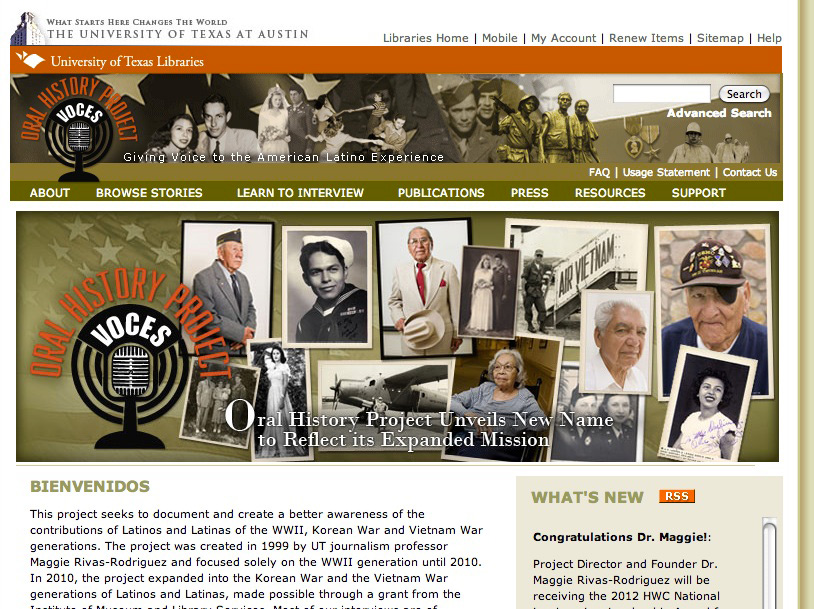 Based out of the University of Texas at Austin, the VOCES Oral History Project (previously the US Latino & Latina WWII Oral History Project) launched the spring of 1999 in response to the dearth of Latin@s experiences in WWII scholarship. Since its inception, the project has conducted over 500 interviews, which have spawned a variety of media, from mini-documentaries to the play Voices of Valor by James E. Garcia. My personal favorite is the Narratives Newspaper (1999-2004), a bi-annually printed collection of stories written by journalism students, based on interviews conducted with the WWII veterans. Thanks to a grant from the Institute for Museum and Library Services, in 2009 VOCES expanded its project to include the Vietnam and Korean Wars — hence the name change.
Based out of the University of Texas at Austin, the VOCES Oral History Project (previously the US Latino & Latina WWII Oral History Project) launched the spring of 1999 in response to the dearth of Latin@s experiences in WWII scholarship. Since its inception, the project has conducted over 500 interviews, which have spawned a variety of media, from mini-documentaries to the play Voices of Valor by James E. Garcia. My personal favorite is the Narratives Newspaper (1999-2004), a bi-annually printed collection of stories written by journalism students, based on interviews conducted with the WWII veterans. Thanks to a grant from the Institute for Museum and Library Services, in 2009 VOCES expanded its project to include the Vietnam and Korean Wars — hence the name change.
VOCES does not have the most technologically innovative or visually attractive website; it relies on text and links much more than contemporary web design generally allows. However, it still serves as a strong, online base for the project, allowing the staff to maintain and occasionally expand the project, and facilitates greater access to the public. For instance, VOCES has transferred the Narratives Newspaper stories into an indexed, online archive, one which they continue to populate with new reports featuring personal photos. The website also helps to sustain the project by inviting the public to participate, encouraging them to sign up for VOCES’ volunteer database or conduct their own interviews. They continue to offer a print subscription to a biannual Narratives Newsletter, which speaks to the manner in which they straddle the line between print and digital. It’s understandable given their audience (i.e. war veterans), yet I wonder if it also hinders a full transition into the digital realm.
The second project that intrigued me was the Freedom Mosaic, a collaboration between the National Center for Civil and Human Rights, CNN and the Ford Foundation to share “individual stories that changed history” from major civil and human rights movements. The Freedom Mosaic is a professionally-designed “microsite” that opens with an attractive, interactive interface made up interviewees’ pictures, which viewers can click on to access multimedia profiles of civil and human rights participants. Each profile includes something like a player’s card for the interviewee on the left side of the page — imagine a title like, “Visionary”, a full body picture, an inspiring quote, personal photos, and perhaps a map. On the right side, viewers can click “Play Story” to watch a mini-documentary on the subject, including interview clips. Viewers can also click the tab “More” at the bottom to bring up a brief text biography, additional interviews and interview transcripts.
 The Freedom Mosaic is not a standard oral history project. According to Dr. Clifford Kuhn, who served as the consulting historian and interviewer, and introduced the site to H-NetOralHist listserv, “The idea was to develop a dynamic web site that departed from many of the archivally-oriented civil rights-themes web sites, in an attempt to especially appeal to younger users, roughly 15-30 years old.” On one hand, I greatly approve of beautifully designed projects that trick the innocent Internet explorer into learning something — and I think the Freedom Mosaic could succeed. However, I’m bothered by the site’s dearth of… history. Especially when sharing contemporary stories like that of immigration activist Jessica Colotl, I would have liked a bit more background on immigration in the United States than her brief bio provides.
The Freedom Mosaic is not a standard oral history project. According to Dr. Clifford Kuhn, who served as the consulting historian and interviewer, and introduced the site to H-NetOralHist listserv, “The idea was to develop a dynamic web site that departed from many of the archivally-oriented civil rights-themes web sites, in an attempt to especially appeal to younger users, roughly 15-30 years old.” On one hand, I greatly approve of beautifully designed projects that trick the innocent Internet explorer into learning something — and I think the Freedom Mosaic could succeed. However, I’m bothered by the site’s dearth of… history. Especially when sharing contemporary stories like that of immigration activist Jessica Colotl, I would have liked a bit more background on immigration in the United States than her brief bio provides.
VOCES and the Freedom Mosaic are excellent examples of how historians may establish a space online, amid the cat memes and indie movie blogs, for academic research. While I have my concerns, I believe both sites succeed in fulfilling their projects’ respective goals, whether that be archiving or eye-catching. However, I would ask you, lovely readers: Is there a template between VOCES’ text heavy archive and the Freedom Mosaic’s dazzling pentagons that might better serve in sharing oral history? What would a rubric for “successful oral history sites” look like? Or should every site be tailor fit to each project?
To the comments! The more you share, the better the eventual OHR website will look.
Caitlin Tyler-Richards is the editorial/ media assistant at the Oral History Review. When not sharing profound witticisms at @OralHistReview, Caitlin pursues a PhD in African History at the University of Wisconsin-Madison. Her research revolves around the intersection of West African history, literature and identity construction, as well as a fledgling interest in digital humanities. Before coming to Madison, Caitlin worked for the Lannan Center for Poetics and Social Practice at Georgetown University.
The Oral History Review, published by the Oral History Association, is the U.S. journal of record for the theory and practice of oral history. Its primary mission is to explore the nature and significance of oral history and advance understanding of the field among scholars, educators, practitioners, and the general public. Follow them on Twitter at @oralhistreview and like them on Facebook to preview the latest from the Review, learn about other oral history projects, connect with oral history centers across the world, and discover topics that you may have thought were even remotely connected to the study of oral history. Keep an eye out for upcoming posts on the OUPblog for addendum to past articles, interviews with scholars in oral history and related fields, and fieldnotes on conferences, workshops, etc.
Subscribe to the OUPblog via email or RSS.
Subscribe to only history articles on the OUPblog via email or RSS.
The post Oral historians and online spaces appeared first on OUPblog.

By:
Bianca Schulze,
on 1/23/2012
Blog:
The Children's Book Review
(
Login to Add to MyJacketFlap)
JacketFlap tags:
Multicultural,
Bilingual Books,
featured,
Latino,
Margarita Engle,
Pura Belpré Award,
Rafael Lopez,
Monica,
Guadalupe Garcia McCall,
Samantha R. Vamos,
Duncan Tonatiuh,
Sara Palacios,
Xavier Garza,
Add a tag
By Bianca Schulze, The Children’s Book Review
Published: January 23, 2012
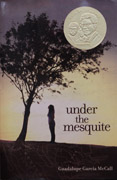
Author Award Winner

Illustrator Award Winner

Author Honor Book
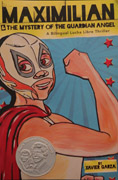
Author Honor Book
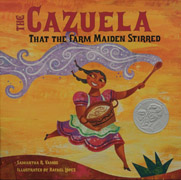
illustrator Honor Book
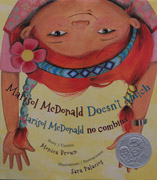
Illustrator Honor Book
“The award is named after Pura Belpré, the first Latina librarian at the New York Public Library. The Pura Belpré Award, established in 1996, is presented annually to a Latino/Latina writer and illustrator whose work best portrays, affirms, and celebrates the Latino cultural experience in an outstanding work of literature for children and youth. It is co-sponsored by the Association for Library Service to Children (ALSC), a division of the American Library Association (ALA), and REFORMA, the National Association to Promote Library and Information Services to Latinos and the Spanish-Speaking, an ALA affiliate.” ~ALSC
©2012 The Childrens Book Review. All Rights Reserved.
.
Author Showcase
By Bianca Schulze, The Children’s Book Review
Published: November 20, 2011
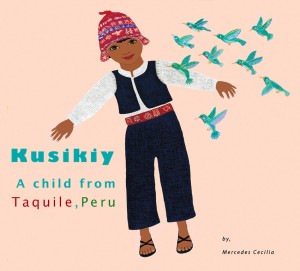 Mercedes Cecilia was born and raised in Peru. She studied Naturopathic methods of healing, Jin Shin Jyutsu. Mercedes Cecilia has won several awards for her paintings, her Art in Education programs and community events.
Mercedes Cecilia was born and raised in Peru. She studied Naturopathic methods of healing, Jin Shin Jyutsu. Mercedes Cecilia has won several awards for her paintings, her Art in Education programs and community events.
Can you share a little on your background and how you became a children’s book writer and illustrator?
When we came to live in USA, storytelling was a way for me to treasure our diversity as immigrants to a new land. At school, in ninth grade I found myself spinning the few English words I knew to weave the stories about the people of the Andes Mountains. When I painted an imaginary portrait to give a face to the Amazon River so that it could tell its own story, my first children’s book began.
What inspired you to write Kusikiy, A Child from Taquile, Peru?
I always wanted to write a book about Peru and I treasure the times I lived with the people of Taquile. Since 1980 I have shared slide presentations of Taquile and other small communities of the Andes of Peru, in different universities, and schools. One day in the summer of 2007, I was having lunch with my 7-year-old grandson, Paulo Andres, and we were talking about condors and glaciers, when he asked me if I could draw the APU, the Spirit of the Great Glacier. This is how the story of Kusikiy started; soon I decide to share the story with everyone.
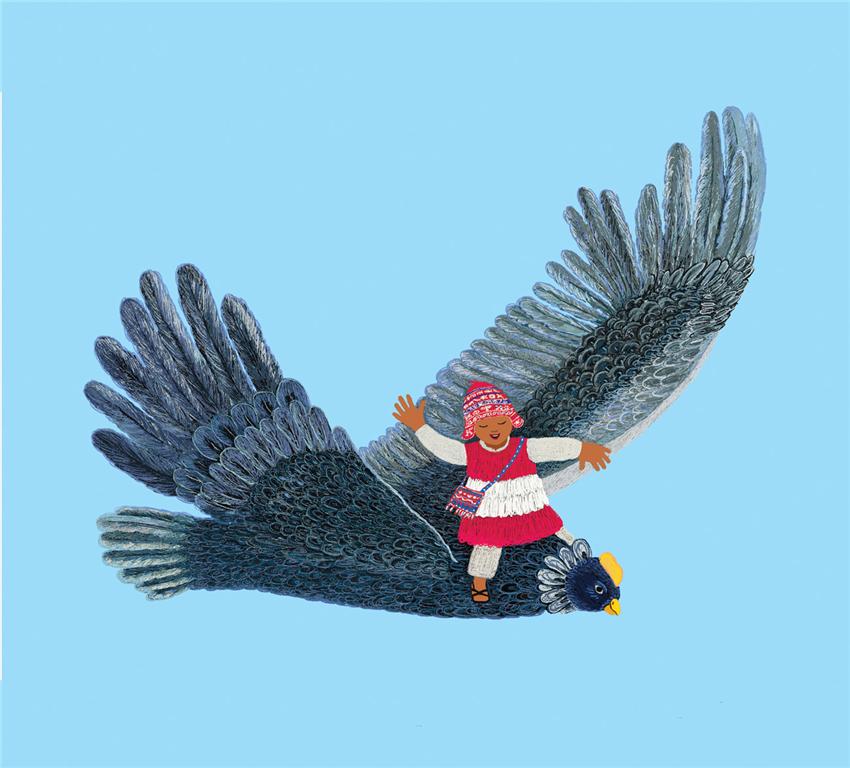
Illustration copyright by Mercedes Cecilia
What age group did you write the book for?
I wrote Kusikiy A Child from Taquile, Peru thinking a child of 5 to 12 would enjoy reading it as well as friends, parents and teachers. I wanted to make a children’s book, because I feel a book with pictures allows the reader to become a co-creator of the story.
Your artwork is rich and vibrant. Can you tell us how you create your illuminating illustrations?
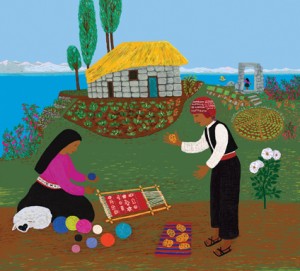
Illustration copyright by Mercedes Cecilia
Thank you. First I did the drawings and used soft pastels on black tinted paper. I chose pastels as a medium, because the mineral pigments use to die wool is similar to the pigments in soft pastels. Because weaving and knitting is central to life in Taquile, I wanted to have those bright and pure colors in the illustrations. After I finished illustrating the story and photographed each painting, I used a digital tool to delineate more of the shapes.
Should we expect to see another book from you soon?
Yes, I am now finishing writing and illustrating the story of a girl from a village of
 Occupy has forced its way into the news this past month, despite the worldwide embarrassment it's causing U.S. political and financial leaders. Our streets don't yet look like those of Greece, but that's what they must fear most: a movement against almost every tenet the privileges of our economic system stand on. [The photos on this post are from Occupy Miami, Madrid, Mexico, Oakland, L.A., So. Korea, Aztlán and more are viewable here.]
Occupy has forced its way into the news this past month, despite the worldwide embarrassment it's causing U.S. political and financial leaders. Our streets don't yet look like those of Greece, but that's what they must fear most: a movement against almost every tenet the privileges of our economic system stand on. [The photos on this post are from Occupy Miami, Madrid, Mexico, Oakland, L.A., So. Korea, Aztlán and more are viewable here.]
 Keith Olbermann's nightly news show covered Occupy Denver on Monday, interviewing protestor Jeannie Harley on the police violence perpetrated on protestors: "We had a perfectly peaceful march, a perfectly peaceful rally, and it turned into something much worse," Harley said.
Keith Olbermann's nightly news show covered Occupy Denver on Monday, interviewing protestor Jeannie Harley on the police violence perpetrated on protestors: "We had a perfectly peaceful march, a perfectly peaceful rally, and it turned into something much worse," Harley said.
 Sorry, Harley, Occupy could develop into a greater threat than the 60s or 70s movements, which were infiltrated, spied on, framed up on charges, incarcerated, beaten and even assassinated. The worst may be yet to come: "The situation we find ourselves in is absolutely unacceptable," said Oakland Metropolitan Chamber of Commerce President Joe Haraburda. "We have made our position clear.… We want Occupy Oakland closed."
Sorry, Harley, Occupy could develop into a greater threat than the 60s or 70s movements, which were infiltrated, spied on, framed up on charges, incarcerated, beaten and even assassinated. The worst may be yet to come: "The situation we find ourselves in is absolutely unacceptable," said Oakland Metropolitan Chamber of Commerce President Joe Haraburda. "We have made our position clear.… We want Occupy Oakland closed."
 Filmmaker, liberal activist Michael Moore stopped by to tell an enthusiastic Occupy Denver crowd of about 1,000 Thursday: "There is no leader to this movement. That's why it's such a large and growing movement."
Filmmaker, liberal activist Michael Moore stopped by to tell an enthusiastic Occupy Denver crowd of about 1,000 Thursday: "There is no leader to this movement. That's why it's such a large and growing movement."
"He said the rest of the country is watching the Occupy protest in Denver."

By:
Bianca Schulze,
on 9/30/2011
Blog:
The Children's Book Review
(
Login to Add to MyJacketFlap)
JacketFlap tags:
Folktales,
Picture Books,
Author Interviews,
Bilingual Books,
Latino,
Author Showcase,
Alma Flor Ada,
Susan Guevara,
Ages Nine to Twelve: Books for Third Through Sixth Grade,
Cultural Wisdom: Books that teach,
Hispanic Heritage,
F. Isabel Campoy,
Vivi Escriva,
Ages Four to Eight: Books for Pre-School Through Second Grade,
Felipe Dávalos,
Leyla Torres,
Add a tag
By Bianca Schulze, The Children’s Book Review
Published: September 30, 2011

F. Isabel Campoy
F. Isabel Campoy is a scholar devoted to the study of language acquisition. She is a well-known author of numerous children’s books in the areas of poetry, theatre, folktales, biographies, and art. She is the recipient of many notable awards, including the Reading the World Award 2004, for “Cuentos que contaban nuestras abuelitas;” and the Junior Library Guild Premier Selection Award, 2006.
TCBR: As a writer, you have a strong focus on the culture and civilization of the Hispanic world. Can you share a little on your background and how you became a children’s book writer?
F. Isabel Campoy: I cannot remember a time in my life in which I wasn’t part of the world of children’s literature. As soon as I learned to read I became the person that teachers chose to read out loud to the rest of the class while they did art, or sewing. I had a good voice and I couldn’t hold a thread and needle for more than two seconds, so it was a perfect match to keep everyone busy. That practice stimulated the writer in me and when I was eleven-years-old I published my first tale in a local magazine. I continued writing throughout my childhood. When I came to the U.S. for the first time at age fifteen in 1963, writing kept me alive through the difficult moments of missing my family (I was here as an AFS exchange student), and conquering my fears after the tragic assassination of John Fitzgerald Kennedy on November of that year.
My first job after college was as an assistant editor in Madrid. I applied to the position because it was my way to be part of the publishing world. Later I was offered the opportunity to co-author with Phillip Locke a series for the teaching of English, my responsibility being to provide the literary texts. I left publishing many years later. At the time, I was a Senior Acquisitions Editor for College publications in a company in Boston. I realized then that the joy of publishing others was hiding my fear to publish my own manuscripts… so I finally quit everything and became a full time writer.
I love to travel. I am interested in the places, the people, and their histories. When I began writing for children I wanted to contribute to present the cultural richness of Latino history, art, and literature for readers in this country. There is much to be written about our culture.
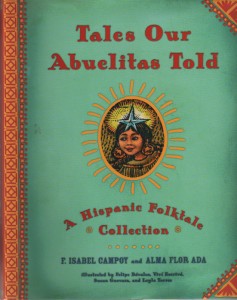 Tales Our Abuelitas Told: A Hispanic Folktale Collection is one of the many books you have written with Alma Flor Ada. Why do you think so many readers are drawn to your retellings of these particular folktales?
Tales Our Abuelitas Told: A Hispanic Folktale Collection is one of the many books you have written with Alma Flor Ada. Why do you think so many readers are drawn to your retellings of these particular folktales?
Authors love all their books, but there are some that connect with you in a very personal way. “Tales Our Abuelitas Told” was published the year I lost my mother. She was the greatest storyteller, imaginative, soft spoken, and these were tales
By:
Bianca Schulze,
on 9/22/2011
Blog:
The Children's Book Review
(
Login to Add to MyJacketFlap)
JacketFlap tags:
Music,
Dogs,
Animals,
Author Interviews,
Bilingual Books,
Spanish,
Latino,
Alma Flor Ada,
Poetry: Rhymes and Verses,
Picture Book - Wordless,
Hispanic Heritage,
F. Isabel Campoy,
Ages Four to Eight: Books for Pre-School Through Second Grade,
Add a tag
Author Showcase
By Bianca Schulze, The Children’s Book Review
Published: September 22, 2011
Alma Flor Ada and F. Isabel Campoy recently published Ten Little Puppies/Diez perritos, a bilingual bonanza!

Alma Flor Ada
Alma Flor Ada is an internationally published children’s book author. She is the recipient of several prestigious honors, including the Pura BelprÉ Award, the Christopher Award, the JosÉ MartÍ World Award, and the Museum of Tolerance Award.

F. Isabel Campoy
F. Isabel Campoy is a scholar devoted to the study of language acquisition. She is a well-known author of numerous children’s books in the areas of poetry, theatre, folktales, biographies, and art.
Hispanic culture and bilingual education are both topics that are important to you. Can you share a little on your background and how you became a children’s book writer?
Culture prepares us to understand the world around us. All cultures evolve, and no culture is perfect, but knowing our roots gives us a sense of community and belonging. The Hispanic culture, a product of multiple heritages, is very rich and has contributed much to the world and to the US society. Latino children have much to learn about their culture. We hope that as they do they will feel enriched by it. When non-Hispanic children learn about our culture they can develop a better understanding of their Latino peers.
Being bilingual has been one of the greatest assets I have enjoyed in life. I wish the same benefit for all children.
I have a strong belief on the importance of family. When children do not acquire, or lose, the ability to speak the language their parents know best, the language they can share feelings, experiences, dreams and beliefs, the parents’ role as educators is eroded and children miss out what should be a valuable part of their heritage.
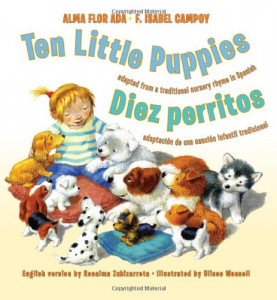 Ten Little Puppies/Diez perritos is a vibrant rendition of the classic Spanish nursery rhyme, co-authored by F. Isabel Campoy and yourself. Can you tell us about your writing partnership and what connected you both to Diez perritos?
Ten Little Puppies/Diez perritos is a vibrant rendition of the classic Spanish nursery rhyme, co-authored by F. Isabel Campoy and yourself. Can you tell us about your writing partnership and what connected you both to Diez perritos?
Both of us sang and enjoyed this nursery rhyme as children, Isabel in Spain, and I in Cuba. Later I sang it with my children who enjoyed singing along. At some point my son Miguel made me aware that sad things happened in many nursery rhymes.
Both Isabel and I believe that young children have a right to joy and happiness so, when we decided to adapt Ten Little Puppies for publication we made sure to find better, and not tragic reasons, for th
By:
Bianca Schulze,
on 1/10/2011
Blog:
The Children's Book Review
(
Login to Add to MyJacketFlap)
JacketFlap tags:
Latino,
Peter Sis,
David Diaz,
Margarita Engle,
Carmen Tafolla,
Pura Belpré Award,
Pam Munoz Ryan,
George Ancona,
Award Winners: Books with honors,
Cultural Wisdom: Books that teach,
Eric Velasquez,
Amy Novesky,
Amy Cordova,
Duncan Tonatiuh,
Enrique Flores-Galbis,
Add a tag
By Bianca Schulze, The Children’s Book Review
Published: January 10, 2011
As announced by the American Library Association (ALA) …
Pura Belpré (Author) Award
Honoring a Latino writer whose children’s books best portray, affirm and celebrate the Latino cultural experience:
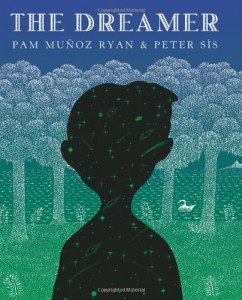
“The Dreamer,” written by Pam Muñoz Ryan, is the 2011 Belpré Author Award winner. The book is illustrated by Peter Sís and published by Scholastic Press, an imprint of Scholastic Inc.
Three BelpréAuthor Honor Books were named:
“¡Olé! Flamenco,” written and illustrated by George Ancona and published by Lee & Low Books Inc.; “The Firefly Letters: A Suffragette’s Journey to Cuba,” written by Margarita Engle and published by Henry Holt and Company, LLC; and “90 Miles to Havana,” written by Enrique Flores-Galbis and published by Roaring Brook Press, a division of Holtzbrinck Publishing.
Pura Belpré (Illustrator) Award
Honoring a Latino illustrator whose children’s books best portray, affirm and celebrate the Latino cultural experience:
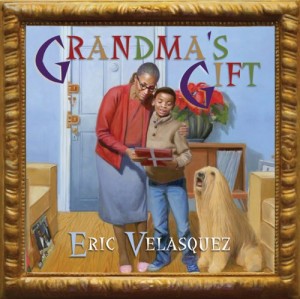
“Grandma’s Gift,” illustrated and written by Eric Velasquez, is the 2011 Belpré Illustrator Award winner. The book is published by Walker Publishing Company, Inc., a division of Bloomsbury Publishing, Inc.
Three Belpré Illustrator Honor Books for illustration were selected:
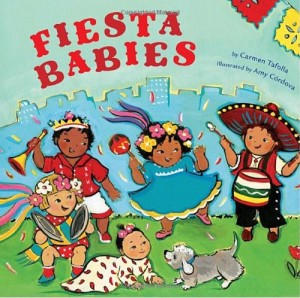
“Fiesta Babies,” illustrated by Amy Córdova, written by Carmen Tafolla and published by Tricycle Press, an imprint of the Crown Publishing Group, a division of Random House, Inc.; “Me, Frida,” illustrated by David Diaz, written by Amy Novesky and published by Abrams Books for Young Readers, an imprint of ABRAMS; “Dear Primo: A Letter to My Cousin,” illustrated and written by Duncan Tonatiuh and published by Abrams Books for Young Readers, an imprint of ABRAMS.
Today marks the last day of Hispanic Heritage Month. So I figured I should post a review to kickstart HHM for the rest of the 335 days of the year (I think that math is right????) We have recommended this book before but now I detail why exactly you should read it.
 Sammy and Juliana in Hollywood by Benjamin Alire Saenz 2004
Sammy and Juliana in Hollywood by Benjamin Alire Saenz 2004
HarperCollins
IQ "'Sometimes dreams come true, don't they Sammy?' [Elena]
I wanted to tell Elena that the bad ones. They're the ones that come true. [Sammy]
But I just said 'Yeah, sometimes dreams come true.'" pg. 213
Sammy Santos does not enjoy living in Hollywood in the 1970s. Hollywood, New Mexico, a small town where the majority of people who live there are Mexican or Mexican American and looked down upon. His mother died of cancer and he takes care of his younger sister (Elena), and at times, his father. Sammy dreams of going to college, so he works hard in school and takes on various jobs. The summer before his senior year, Sammy falls in love with gorgeous, vulnerable, aloof Juliana. But what would a love story be without some tragedy? Sammy introduces us to his family, Juliana, his friends and their stories of love and loss, suffering and triumph.
This was a re-read for me and I don't remember much about it. Which is mind-boggling because upon re-reading it, I absolutely LOVED it. I remember that I really liked it and I remember being relatively young when I read it. I bought it somewhere that was selling it for a bargain price ($4) when I was in 5th or 6th grade, and there are two things I vividly remember from the book. I remember that it was the first book I read that had so many Spanish words. I learned many curse and slang words and I'm oddly appreciative of that. I also recall it being one of the first books I ever read to candidly discuss homosexuality (I also learned about the awful slur "queer"). Upon re-reading this book I think both of those points are important. There is no glossary in this book, no italics to show that it is a Spanish word. The reader must figure that out from themselves and use the context in order to translate it. I encourage readers to not just skip over the Spanish words, but to learn them (especially if you are pretty good at Spanish, you need to know the slang too, not just the formal talk. My friends who speak Spanish laugh at Spanish students "proper" Spanish). As for the look at how gay people were treated, I don't think many current students know how bad homosexuals had it in the '60s and '70s, even though that was supposed to be a "liberating and accepting" time. Sammy says it best concerning what love is deemed acceptable "It's funny, everyone had always told us love was another word for belonging. No one, no one had ever told me that love was another name for exile." (pg. 212) I wish it was funny because it was untrue, but it's not funny, and it's true.
The nice thing about re-reading is you find new things to appreciate. I was enthralled by how Sammy described people. I wanted to meet him just to hear how he would describe me. When talking about Juliana he says, "Sometimes, she could look at you and you could see what she was trying to tell you don't screw with me because I've been through things, and you don't know a damn thing about what it's cost me to be here, right here, right here on this worthless piece of ground, so don't treat me like I'm some crack on a sidewalk because if y

Full name: Barbara Caridad Ferrer (Yes, the Caridad is really mine!) Location: New York, NY
Genre: Contemporary/Multicultural Young Adult
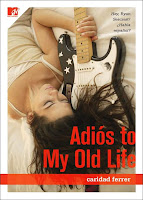
WiP or most recently published work: When the Stars Go Blue (St. Martin's Griffin/November 2010)
Writing credits: Adiós to My Old Life (2006); It's Not About the Accent (2007)
How frequently do you update your site?
I blog regularly and since the site is built on a blog platform, fairly frequently. It also contains my Twitter feed, so  you could say that my site is constantly being updated.
you could say that my site is constantly being updated.
Is your site designed for reader interaction?
Definitely. Between email contact, my Twitter feed and the blog entries, I love hearing from and interacting with readers.
Post of note, something in particular you want readers to check out:

Full name: Jennifer Cervantes<?xml:namespace prefix = o ns = "urn:schemas-microsoft-com:office:office" />
Birth date: 12/30
Location: San Diego, Ca.
Website/blog: www.jennifercervantes.com
Genre: Middle-Grade Fiction
WiP or most recently published work: TORTILLA SUN
How frequently do you update your site? It all depends on events, press, reviews. Some months are busier than others. But I'd say at least once every couple of months.
.jpeg?picon=3655)
By: frootjoos,
on 8/5/2010
Blog:
Read Now Sleep Later
(
Login to Add to MyJacketFlap)
JacketFlap tags:
Latin,
Cuban,
5,
history,
fiction,
young adult,
middle grade,
5 stars,
Spanish,
Latino,
Latina,
Add a tag
The Red Umbrella by Christina Diaz Gonzalez
Publication date: May 11, 2010
ISBN 10/13: 0375861904 / 9780375861901
Category: Middle Grade/Young Adult Fiction
Format: Hardcover
Keywords: Identity, Culture, Revolution, Evacuation, Family, Historical Fiction
Find the synopsis on goodreads.com. How I found out about this book: The Story Siren's 2010 Debut Author Challenge led me to look for more new authors. I read the synopsis and thought, this is going to be great!
My Review: I'd never really thought about Castro's 1961 takeover of Cuba and its effect on children. I'd never even heard of Operation Pedro Pan, which flew lots of Cuban refugees, in their teens and younger, into the US.
The Red Umbrella gives a moving, personal glimpse into the life of Lucia, just 14 years old, who is sent with her little brother to live in Nebraska.
I adored this book. The possibility that Lucy and Frankie may never see their parents again kept bringing tears to my eyes. Lucy's just a regular girl, concerned with cute boys, the latest fashions, and going to the movies with her friends. Strange things begin to happen in their little town as a result of the Communist takeover, and it's interesting to see how she learns to deal with these changes. The lessons she learns about strength, family and friendship will stick with readers long after the symbolic red umbrella makes its final appearance.
I kept wondering, if I were in her shoes, would I have fallen for all the brainwashing, the Communists' calls to "honor" and "duty" that tore children from their families and sent them into dangerous places? Would I have thought that I was doing the right thing to turn in someone who was being disloyal to the government? It's easy now with hindsight, and because I am at least twice the character's age, but I still found her reactions unsettling and was very satisfied with the character development in this book.
I also felt very connected to Lucia's culture--they use some of the same words we say in the Philippines, like "basta" and "sigue"! I love flan just as much as her little brother Frankie does (that reminds me, there's some in the fridge, BRB).
Who should read this book: Middle grade readers will have a fine time with this book. It would be interesting to know how non-Spanish speakers react to the interjected lines of Spanish. My grasp of Spanish is good enough to be able to read through and not get lost, and the glossary in the back of the book helps, too! There is a little hint of death and violence, but most of the action is happening at a remove, and is not quite so scary as it could be. I think everyone should read this book with a box of tissues. And I think Pedro Pan kids, and their kids/grandkids should read it together, and share those tissue boxes!
 Sweet Mary by Liz Balmaseda
Sweet Mary by Liz Balmaseda
Balmaseda is a two time Pulitzer Prize winning journalist and this is her first novel. It was one of my favorite mystery debuts of 2009
Dulce Maria (Mary) Guevara is a single mother and a very successful Miami real estate agent. Mary has worked hard to provide a nice home for her and son, Max. Mary's life is turned upside down when she is mistaken for a drug queen pin. One morning the FBI searches Mary's house and she's arrested in front of her son. After the charges are dropped, Mary realizes the only way to get her life back and not lose custody of her son is to catch the real criminal.
Sweet Mary was such a pleasure to read. I loved it. Mary is a wonderfully crafted character. Part of the beauty of this mystery is Mary comes across as a real person. She is an accidental sleuth, like Laura Lippman's Tess Monaghan or Kyra Davis's Sophie Katz.
One of the many strengths of this story is the relationship between Mary and her best friend Gina Torres. Gina helps search for the real criminal. Balmaseda allows the reader to get a good taste of the city of Miami. Sweet Mary is a wonderful addition to the mystery genre.
.jpg?picon=107)
By:
Lizzy Burns,
on 11/26/2009
Blog:
A Chair, A Fireplace and A Tea Cozy
(
Login to Add to MyJacketFlap)
JacketFlap tags:
picture books,
pat mora,
latino,
john parra,
hispanic,
bilingual,
thanks,
lee and low,
reviews,
Add a tag

Gracias / Thanks (English and Spanish Edition) by Pat Mora. Illustrations by John Parra. Lee & Low Books. 2009. Review copy supplied by publisher.
by Pat Mora. Illustrations by John Parra. Lee & Low Books. 2009. Review copy supplied by publisher.
The Plot: A young boy gives thanks for the people and things in his life, starting with "for the sun that wakes me up so I don't sleep for years and years and grow a long, white beard, thanks."
In both English and Spanish: "Por el sol que me despierta y no permite que siga durmiendo por anos y anos, y que me crezca una larga barba blanca, gracias."
The Good: Anyone (boy, girl, adult, child) will identify with what the narrator is thankful for. And, of course, the reader can then add what they are thankful for. The book is both mirror and window, anyone seeing a ladybug; and (for some), window when the boy gives thinks for his "Abuelita."
I loved the illustrations by Parra; they, add to the multicultural aspect of the book, along with the use of Spanish and English. The folk-art story is both appealing and also works for this story; additional details flesh out the story. When the "ladybug that landed on my finger," the narrator has a book on insects, another open to a page on ladybugs, a baseball glove; stylized birds and butterflies fill up the page. The colors are rich and gorgeous; blues, yellows, reds that spring off the page.
I'm posting this on Thanksgiving, because it's a great book to use for giving thanks. But, because there is no mention of holidays here, it's not limited to Thanksgiving and can be used any time.
Amazon Affiliate. If you click from here to Amazon and buy something, I receive a percentage of the purchase price.
© Elizabeth Burns of A Chair, A Fireplace & A Tea Cozy
.jpeg?picon=1058)
By:
Kakie Fitzsimmons,
on 10/10/2009
Blog:
Bur Bur & Friends: Community Blog
(
Login to Add to MyJacketFlap)
JacketFlap tags:
multicultural,
community,
kids,
Diversity,
education,
cultural,
teachers,
Community Board,
Latino,
multicultural kids,
communities,
celebrating differences,
educator resources,
family activity,
healthy families,
Hispanic Heritage Month Resources,
multiracial,
Add a tag
Hispanic Heritage Month runs from September 15- October 15th. It is this month that celebrates the anniversary of independance from 5 Latin American countries that include Costa Rica, El Salvador, Guatamala, Honduras and Nicaragua. In addition, Mexico declared it’s independance day on September 18th, and Chile on September 15th.
At Farmer’s Hat Productions, our tagline is [...]

By: Ashley,
on 10/1/2008
Blog:
OUPblog
(
Login to Add to MyJacketFlap)
JacketFlap tags:
Film,
Sociology,
hollywood,
American History,
A-Featured,
Latino,
Lover,
Latin,
Clara Rodríguez,
Latin Lover,
Add a tag
Ashley- Intern
Heroes, Lovers, and Others: The Story of Latinos in Hollywood by Clara E. Rodríguez recounts the stories of Latino actors and actresses from the era of silent film to the present day. Rodríguez, a Professor of Sociology and Anthropology at Fordham University, examines the social conditions and assumptions that influenced the portrayal of Latinos in American film and their reception by the public. In the following excerpt from Rodríguez’ book, we learn about the typecasting of Latino actors, and specifically, about the role of the “Latin Lover.”
Options for Latinos
With a few important exceptions, many of the films that featured Latino characters during this [cold war] era focused on social problems and were steeped in historical myths, machismo, or stereotypes of Latin lovers and Latina bombshells. (Indeed, strong female stars of all backgrounds were also shunted aside during this era.) The choices for Latino actors were generally limited: They could either Europeanize their images (by  discarding any ethnic references) or play up the stereotypes. Consequently, in this period, the distinction between visible and invisible Latino actors became stronger, and invisibility became a more clear-cut strategy for navigating identity and careers. The absence of middle-ground positions in film reflected the intolerance for ambiguity characteristic of this era. The roles available often called for proverbial characters: victims incapable of defending themselves, vixens, alien invaders, and young punks. In essence, fewer roles were open to Latino actors, and of the few that were available many were mere clichés. Some actors also became victims of the McCarthyism that was emblematic of the times.
discarding any ethnic references) or play up the stereotypes. Consequently, in this period, the distinction between visible and invisible Latino actors became stronger, and invisibility became a more clear-cut strategy for navigating identity and careers. The absence of middle-ground positions in film reflected the intolerance for ambiguity characteristic of this era. The roles available often called for proverbial characters: victims incapable of defending themselves, vixens, alien invaders, and young punks. In essence, fewer roles were open to Latino actors, and of the few that were available many were mere clichés. Some actors also became victims of the McCarthyism that was emblematic of the times.
Latin Lovers, Bombshells, Spitfires, and Sultry Latinas
Some might wonder why being seen as a Latin lover, or a Latina bombshell, is problematic. What is so wrong with this? First, it should be made clear that in Hollywood movies at the time there was not much distinction (other than the obvious) between Latin lovers, bombshells, spitfires, and sultry Latinas; the difference was often merely a matter of degree or gender. It should also be made clear that Latin lover and Latina bombshell characterizations were in many ways desirable. They were the men and women that audiences yearned to touch, lusted after, the ones their mothers had warned them about; they made their viewers’ hearts skip a beat and promised rapture and full surrender. What was wrong with being projected as sexually desirable? Don’t most of us strive for this in one way or another or at one time or another?
The problem was that, in the case of Latinos, the characters were erotic and exotic, and little else. The dark, forbidden, dream lovers generally had no other role; they were not lucky in love, and they frequently preferred non-Latinos as partners. The characters were often morally inferior and ended up reinforcing the comfortable American status quo that relegated people like them to the back seat. True, the Latino characters inspired unspeakable desire and desirability, especially at this time, when non-Latin men and women were often portrayed as prim, clumsy, restrained sexual partners. In the end, however, once the escapist fantasy had subsided, it was the non-Latinos who had the good morals, sense, and intelligence and were “the real thing”—the ones to be taken seriously in marriage, as well as in other areas of life.
ShareThis

By: Erica Olsen,
on 2/15/2008
Blog:
Librarian Avengers
(
Login to Add to MyJacketFlap)
JacketFlap tags:
mission,
San Francisco,
The Mission,
cultura,
latinamericano,
latino,
The Mission,
cultura,
latinamericano,
Life,
valentine,
latino,
San Francisco,
mission,
Add a tag
 onight I walked home from the 24th and Mission BART stop. It was Valentine’s day, and the neighborhood celebrated by being outside.
onight I walked home from the 24th and Mission BART stop. It was Valentine’s day, and the neighborhood celebrated by being outside.
Stores stayed open late. Perfumed Latino guys pushed and egged each other on, nervously buying flowers for sweethearts and would-be sweethearts. The bodas civiles joints lubricated their trade with sidewalk tables of cheap teddy bears wrapped in red cellophane.
I walked home in my pink dress. Women holding little girls walked by, clutching roses, boxes of chocolates. Women completed errands, hauled children, and bought food with the same grim determination, red cellophane emerging from their purses.
I saw a beautifully happy couple. Their little daughter ran up the sidewalk in front of them. I caught the man’s eye as I passed and saw satisfaction on his face.
More people were on the street than usual. More police were around. I saw two huge officers, giants. One had his hand on the back of a tiny fast-talking man. There was no sense of potential violence, just a solid hand on the back and a posture that clearly communicated that whatever jig there may have been was now thoroughly up.
There was music and the smell of onions cooking. The jazz club was setting up a show. As I walked home, buses drove back and forth full of people like me, heading home, and out, and home again.
View Next 4 Posts
 When I saw Welcome to My Neighborhood: A Barrio ABC at the library, I was immediately intrigued. I am always interested in books about people of color and since my daughter is half Latina, I wanted to see what this book was about.
When I saw Welcome to My Neighborhood: A Barrio ABC at the library, I was immediately intrigued. I am always interested in books about people of color and since my daughter is half Latina, I wanted to see what this book was about.














 Based out of the University of Texas at Austin, the VOCES Oral History Project (previously the US Latino & Latina WWII Oral History Project) launched the spring of 1999 in response to the dearth of Latin@s experiences in WWII scholarship. Since its inception, the project has conducted over 500 interviews, which have spawned a variety of media, from
Based out of the University of Texas at Austin, the VOCES Oral History Project (previously the US Latino & Latina WWII Oral History Project) launched the spring of 1999 in response to the dearth of Latin@s experiences in WWII scholarship. Since its inception, the project has conducted over 500 interviews, which have spawned a variety of media, from  The Freedom Mosaic is not a standard oral history project. According to Dr. Clifford Kuhn, who served as the consulting historian and interviewer, and introduced the site to H-NetOralHist listserv, “The idea was to develop a dynamic web site that departed from many of the archivally-oriented civil rights-themes web sites, in an attempt to especially appeal to younger users, roughly 15-30 years old.” On one hand, I greatly approve of beautifully designed projects that trick the innocent Internet explorer into learning something — and I think the Freedom Mosaic could succeed. However, I’m bothered by the site’s dearth of… history. Especially when sharing contemporary stories like that of
The Freedom Mosaic is not a standard oral history project. According to Dr. Clifford Kuhn, who served as the consulting historian and interviewer, and introduced the site to H-NetOralHist listserv, “The idea was to develop a dynamic web site that departed from many of the archivally-oriented civil rights-themes web sites, in an attempt to especially appeal to younger users, roughly 15-30 years old.” On one hand, I greatly approve of beautifully designed projects that trick the innocent Internet explorer into learning something — and I think the Freedom Mosaic could succeed. However, I’m bothered by the site’s dearth of… history. Especially when sharing contemporary stories like that of 



































 onight I walked home from the 24th and Mission
onight I walked home from the 24th and Mission
I am so thrilled to hear that this book is out! I was in a workshop with Estela in 2009 (we were roommates too!), and she presented an earlier draft of the novel. I was fortunate to have been able to read that early draft in its entirety, and now I’m looking forward to reading the PUBLISHED version to see how it’s changed. My own experience in that workshop was very positive as well, as I was able to get unstuck on a project that’s coming out next year. (My next to last blog post talks about the workshop and what we did.) Kudos to Estela, the other folks in the workshop, and its leader, Barbara Seuling! And thank you, Edi, for interviewing Estela and bringing Can You See Me Now? to my attention!
Lyn,
Your endorsement speaks volumes! I’m waiting to receive Estela’s book along with Rene Saldana’s latest. Stay tuned for reviews!